Manufacturing and Testing of Radio Frequency MEMS Switches Using the Complementary Metal Oxide Semiconductor Process
Abstract
1. Introduction
2. Structure of MSS
3. Fabrication of MMS
4. Results
5. Conclusions
Author Contributions
Funding
Institutional Review Board Statement
Informed Consent Statement
Data Availability Statement
Acknowledgments
Conflicts of Interest
References
- Goel, S.; Gupta, N. Design, optimization and analysis of reconfigurable antenna using RF MEMS switch. Microsyst. Technol. 2020, 26, 2829–2837. [Google Scholar] [CrossRef]
- Daneshmand, M.; Mansour, R.R. RF MEMS Satellite Switch Matrices. IEEE Microwave Mag. 2011, 12, 92–109. [Google Scholar] [CrossRef]
- Donelli, M.; Iannacci, J. Exploitation of RF-MEMS Switches for the Design of Broadband Modulated Scattering Technique Wireless Sensors. IEEE Antennas Wirel. Propag. Lett. 2019, 18, 44–48. [Google Scholar] [CrossRef]
- Zhang, N.B.; Mei, L.R.; Wang, C.T.; Deng, Z.L.; Yang, J.; Guo, Q.Q. A Switchable Bandpass Filter Employing RF MEMS Switches and Open-Ring Resonators. IEEE Trans. Electron Devices 2017, 64, 3377–3383. [Google Scholar] [CrossRef]
- Fukuda, A.; Okazaki, H.; Hirota, T.; Yamao, Y. Novel Band-Reconfigurable High Efficiency Power Amplifier Employing RF-MEMS Switches. IEICE Trans. Electron. 2005, E88C, 2141–2149. [Google Scholar] [CrossRef]
- Raki, H.; Koon, K.T.V.; Saniour, I.; Souchay, H.; Lambert, S.A.; Robb, F.; Beuf, O. Serial and Parallel Active Decoupling Characterization Using RF MEMS Switches for Receiver Endoluminal Coils at 1.5 T. IEEE Sens. J. 2020, 18, 10511–10520. [Google Scholar] [CrossRef]
- Benoit, R.R.; Rudy, R.Q.; Pulskamp, J.S.; Polcawich, R.G. Piezoelectric RF MEMS Switches on Si-on-Sapphire Substrates. J. Microelectromech. Syst. 2020, 29, 1087–1090. [Google Scholar] [CrossRef]
- Chae, U.; Yu, H.-Y.; Lee, C.; Cho, I.-J. A Hybrid RF MEMS Switch Actuated by the Combination of Bidirectional Thermal Actuations and Electrostatic Holding. IEEE Trans. Microwave Theory Tech. 2020, 68, 3461–3470. [Google Scholar] [CrossRef]
- Swarnkar, A.; DasGupta, A.; Nair, D.R. Design, fabrication and characterization of RF MEMS shunt switch for wideband operation of 3 GHz to 30 GHz. J. Micromech. Microeng. 2019, 29, 115009. [Google Scholar] [CrossRef]
- Mafinejad, Y.; Ansari, H.R.; Khosroabadi, S. Development and optimization of RF MEMS switch. Microsyst. Technol. 2019, 26, 1253–1263. [Google Scholar] [CrossRef]
- Anuroop; Bansal, D.; Kumar, P.; Kumar, A.; Khushbu; Rangra, K. Low temperature epoxy bonding for RF MEMS capacitive switch. Microsyst. Technol. 2019, 25, 3047–3051. [Google Scholar] [CrossRef]
- Savin, E.A.; Bochkova, E.N.; Kirtaev, R.V.; Iannacci, J. RF MEMS packaged switch evaluation tests up to 25GHz. Microsyst. Technol. 2019, 25, 2191–2195. [Google Scholar] [CrossRef]
- Naito, Y.; Nakamura, K.; Uenishi, K. Laterally Movable Triple Electrodes Actuator toward Low Voltage and Fast Response RF-MEMS Switches. Sensors 2019, 19, 864. [Google Scholar] [CrossRef] [PubMed]
- Rao, K.S.; Thalluri, L.N.; Guha, K.; Sravani, K.G. Fabrication and Characterization of Capacitive RF MEMS Perforated Switch. IEEE Access 2018, 6, 77519–77528. [Google Scholar]
- Liu, Y.H.; Bey, Y.S.; Liu, X.G. High-Power High-Isolation RF-MEMS Switches With Enhanced Hot-Switching Reliability Using a Shunt Protection Technique. IEEE Trans. Microwave Theory Tech. 2017, 65, 3188–3199. [Google Scholar] [CrossRef]
- Lin, C.-Y.; Hsu, C.-C.; Dai, C.-L. Fabrication of a Micromachined Capacitive Switch Using the CMOS-MEMS Technology. Micromachines 2015, 6, 1645–1654. [Google Scholar] [CrossRef]
- Yang, M.-Z.; Dai, C.-L.; Shih, P.-J.; Tsai, Z.-Y. Capacitive RF switches manufactured by the CMOS-MEMS technique. Microelectron. Eng. 2011, 88, 2242–2246. [Google Scholar] [CrossRef]
- Dai, C.-L.; Peng, H.-J.; Liu, M.-C.; Wu, C.-C.; Hsu, H.-M.; Yang, L.-J. A Micromachined Microwave Switch Fabricated by the Complementary Metal Oxide Semiconductor Post-Process of Etching Silicon Dioxide. Jpn. J. Appl. Phys. 2005, 44, 6804–6809. [Google Scholar] [CrossRef]
- Perelló-Roig, R.; Verd, J.; Bota, S.; Segura, J. Thermomechanical Noise Characterization in Fully Monolithic CMOS-MEMS Resonators. Sensors 2018, 18, 3124. [Google Scholar] [CrossRef]
- Dai, C.-L.; Hsu, H.-M.; Tsai, M.-C.; Hsieh, M.-M.; Chang, M.-W. Modeling and fabrication of a microelectromechanical microwave switch. Microelectron. J. 2007, 38, 519–524. [Google Scholar] [CrossRef]
- Lin, C.-Y.; Dai, C.-L. Manufacture of Radio Frequency Micromachined Switches with Annealing. Sensors 2014, 14, 1680–1690. [Google Scholar] [CrossRef] [PubMed]
- Yang, M.-Z.; Dai, C.-L. Ethanol Microsensors with a Readout Circuit Manufactured Using the CMOS-MEMS Technique. Sensors 2015, 15, 1623–1634. [Google Scholar] [CrossRef]
- Hsieh, C.-H.; Dai, C.-L.; Yang, M.-Z. Fabrication and Characterization of CMOS-MEMS Magnetic Microsensors. Sensors 2013, 13, 14728–14739. [Google Scholar] [CrossRef] [PubMed]
- Yang, M.-Z.; Dai, C.-L.; Shih, P.-J. An Acetone Microsensor with a Ring Oscillator Circuit Fabricated Using the Commercial 0.18 μm CMOS Process. Sensors 2014, 14, 12735–12747. [Google Scholar] [CrossRef] [PubMed]
- Dai, C.-L.; Chen, Y.-C.; Wu, C.-C.; Kuo, C.-F. Cobalt Oxide Nanosheet and CNT Micro Carbon Monoxide Sensor Integrated with Readout Circuit on Chip. Sensors 2010, 10, 1753–1764. [Google Scholar] [CrossRef] [PubMed]
- Yang, M.-Z.; Wu, C.-C.; Dai, C.-L.; Tsai, W.-J. Energy Harvesting Thermoelectric Generators Manufactured Using the Complementary Metal Oxide Semiconductor Process. Sensors 2013, 13, 2359–2367. [Google Scholar] [CrossRef] [PubMed]
- Senturia, S.D. Microsystem Design; Kluwer Academic: Norwell, MA, USA, 2001. [Google Scholar]
- Dai, C.-L.; Chang, Y.-M. A resonant method for determining mechanical properties of Si3N4 and SiO2 thin films. Mater. Lett. 2007, 61, 3089–3092. [Google Scholar] [CrossRef]
- Dai, C.-L. A maskless wet etching silicon dioxide post-CMOS process and its application. Microelectron. Eng. 2006, 83, 2543–2550. [Google Scholar] [CrossRef]
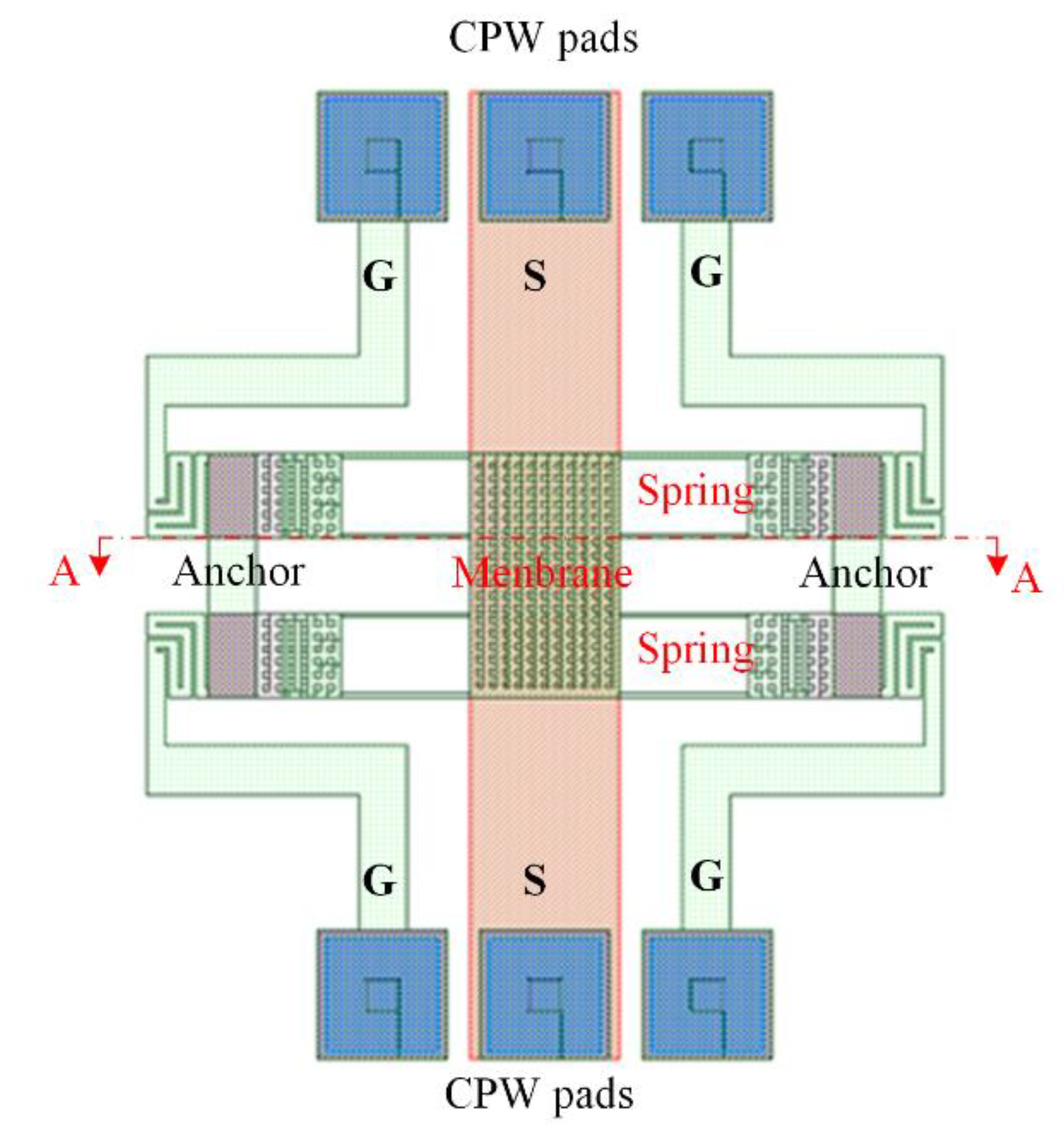
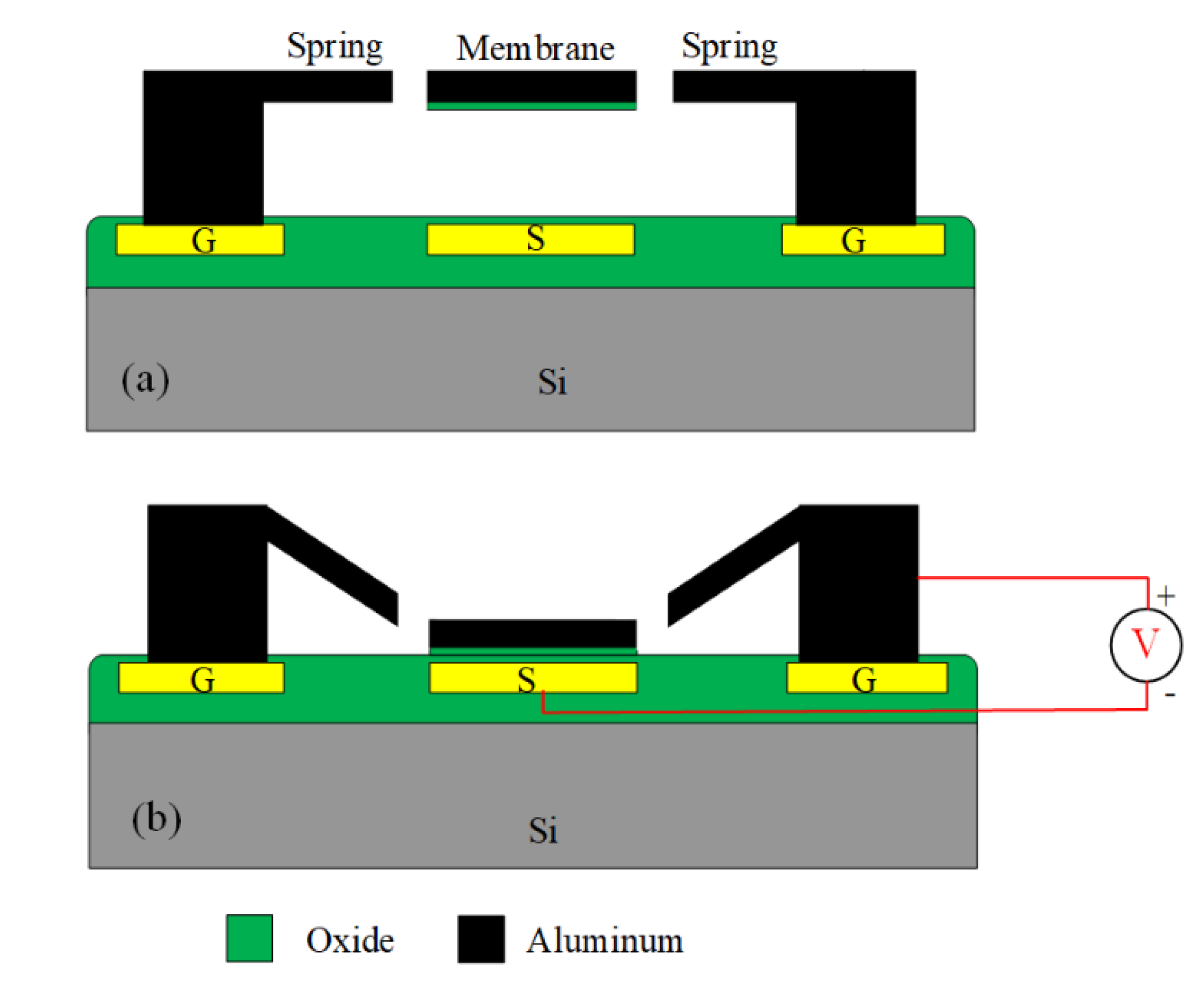

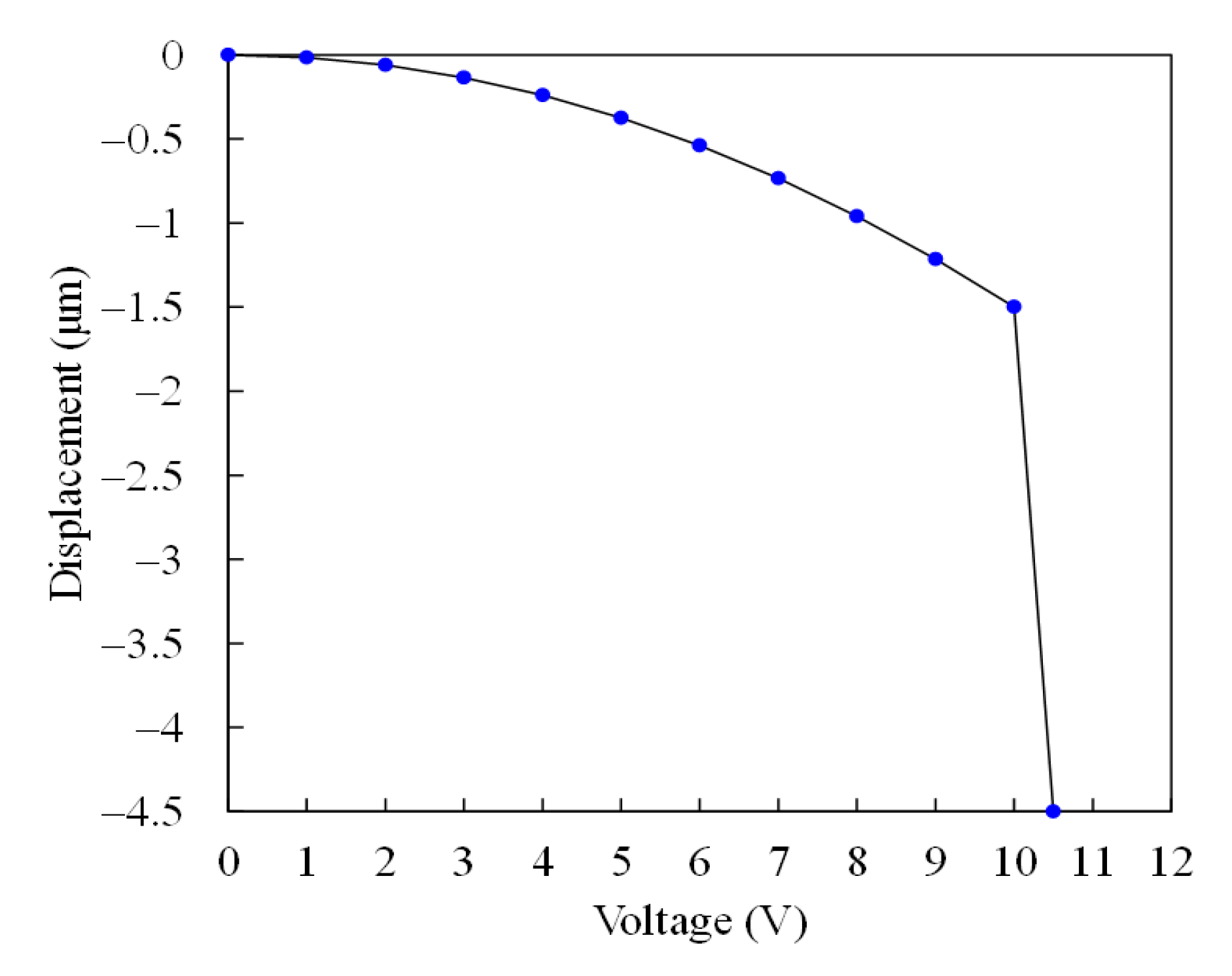
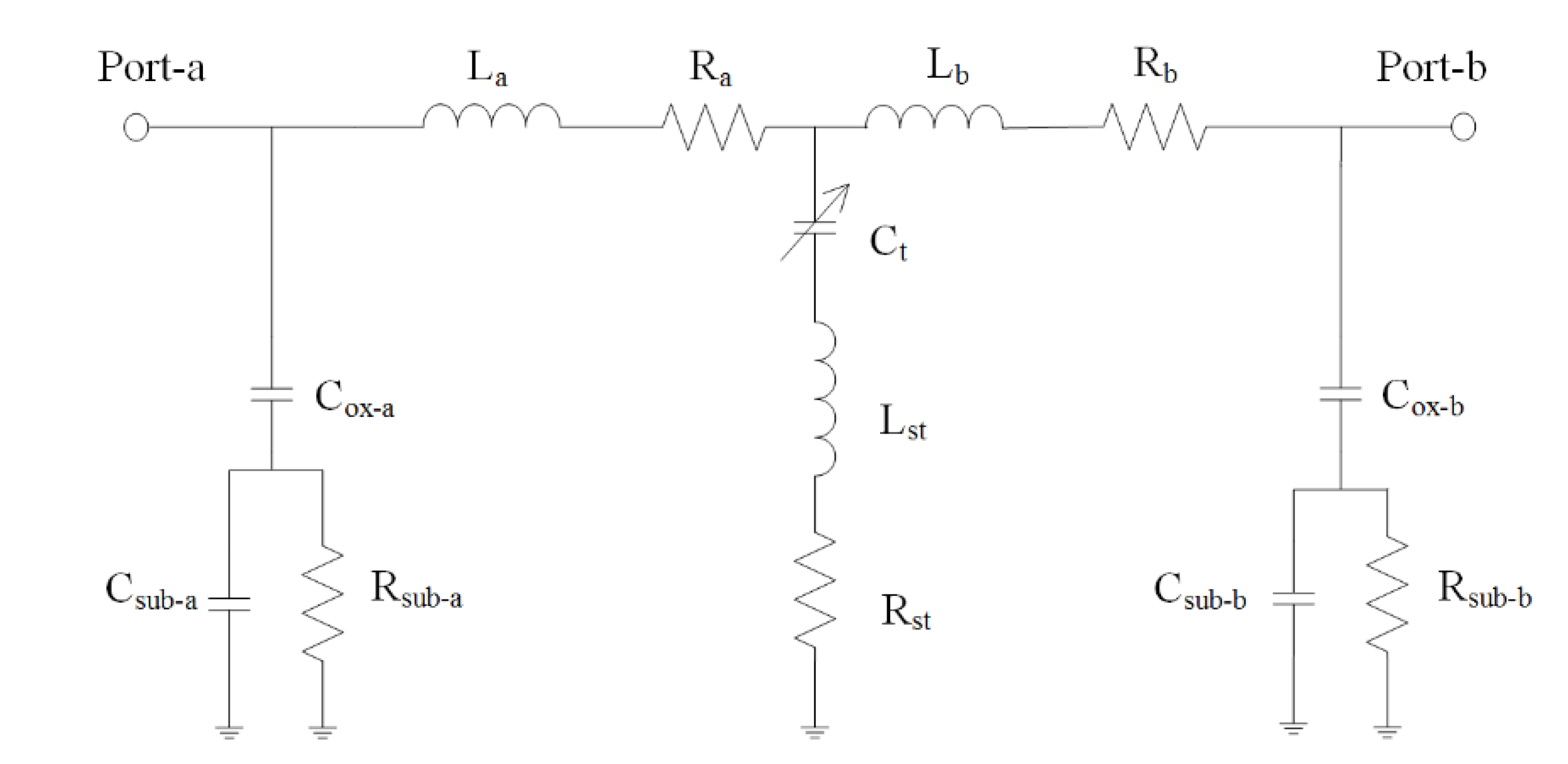
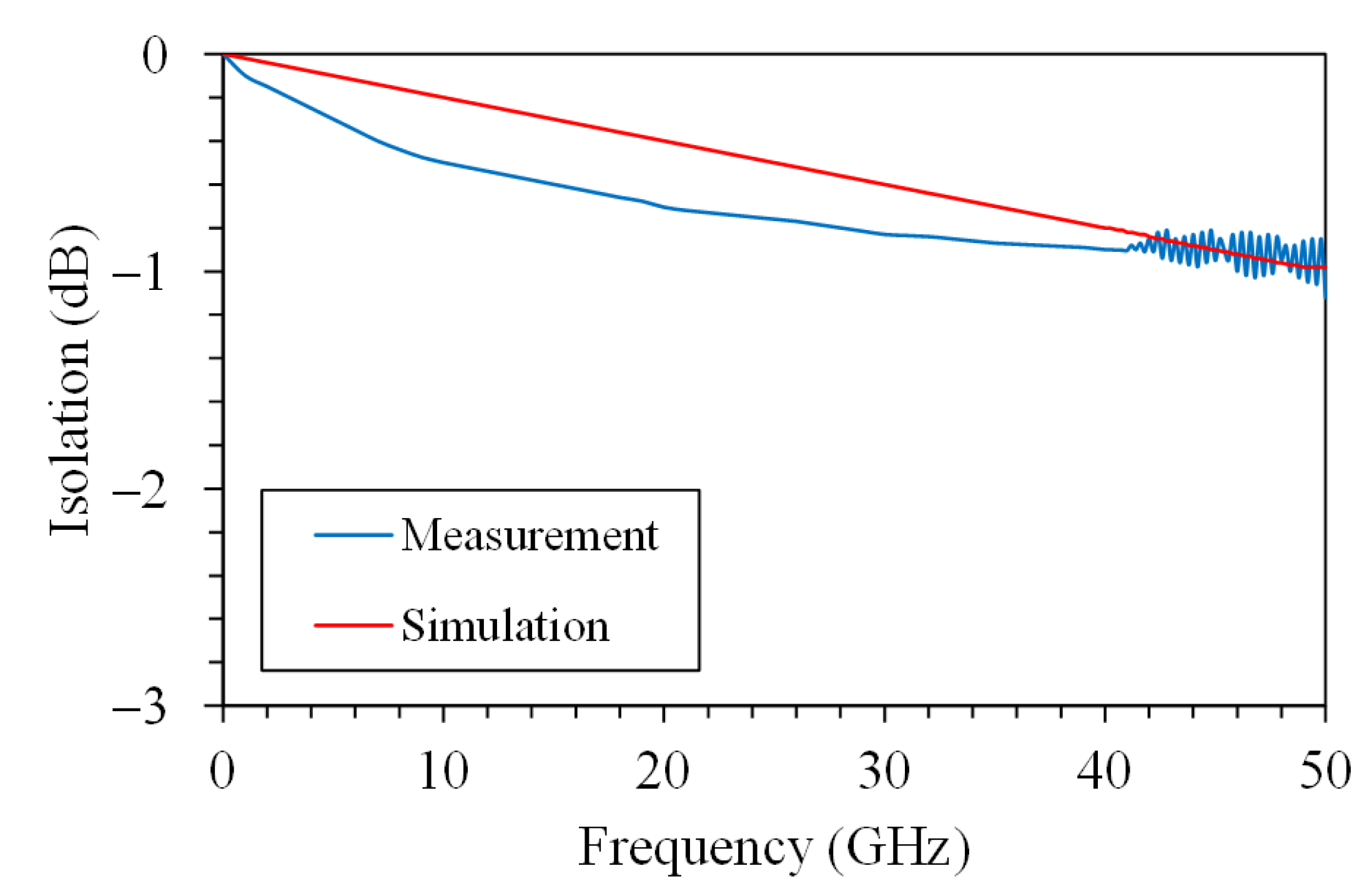

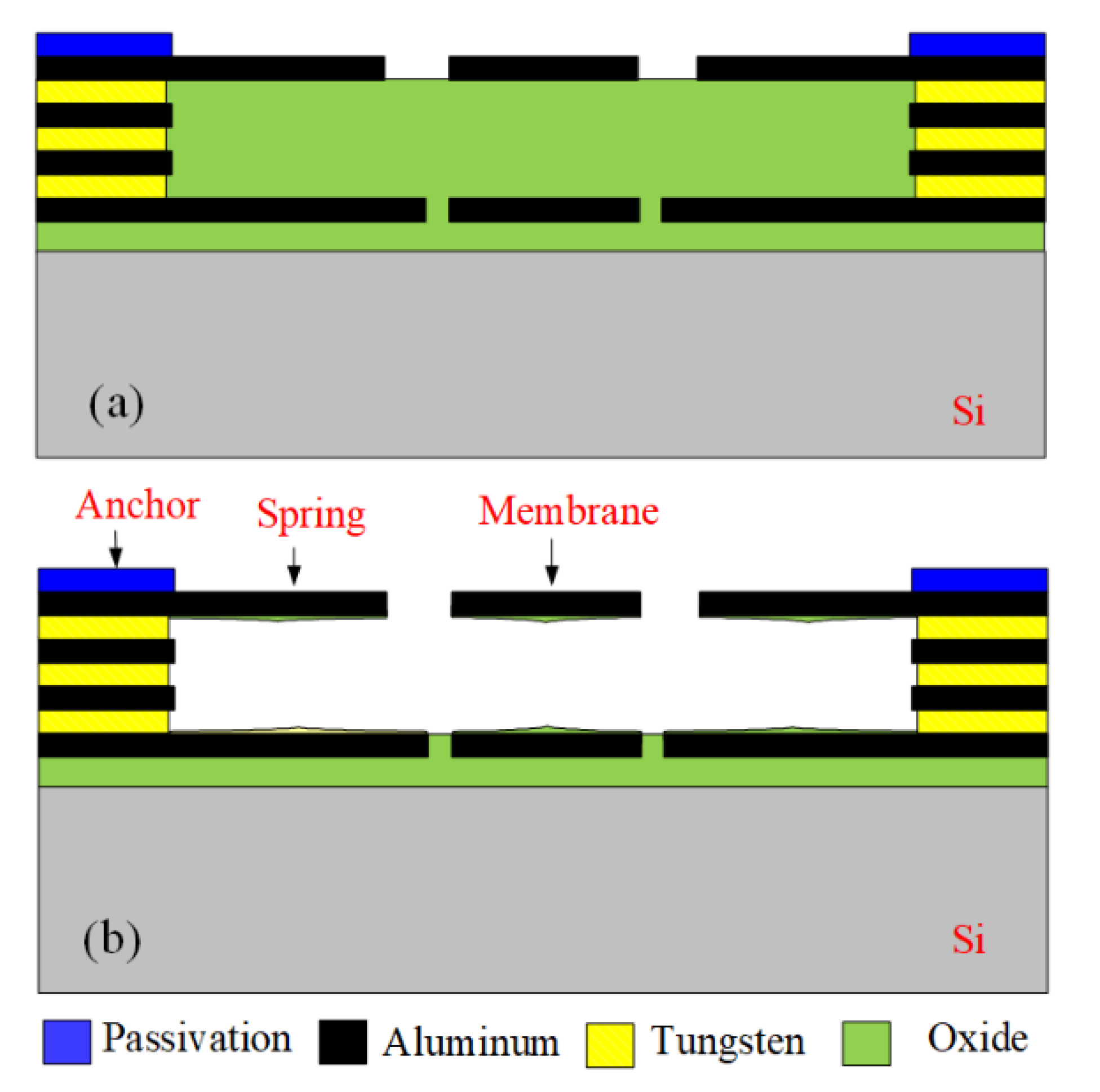

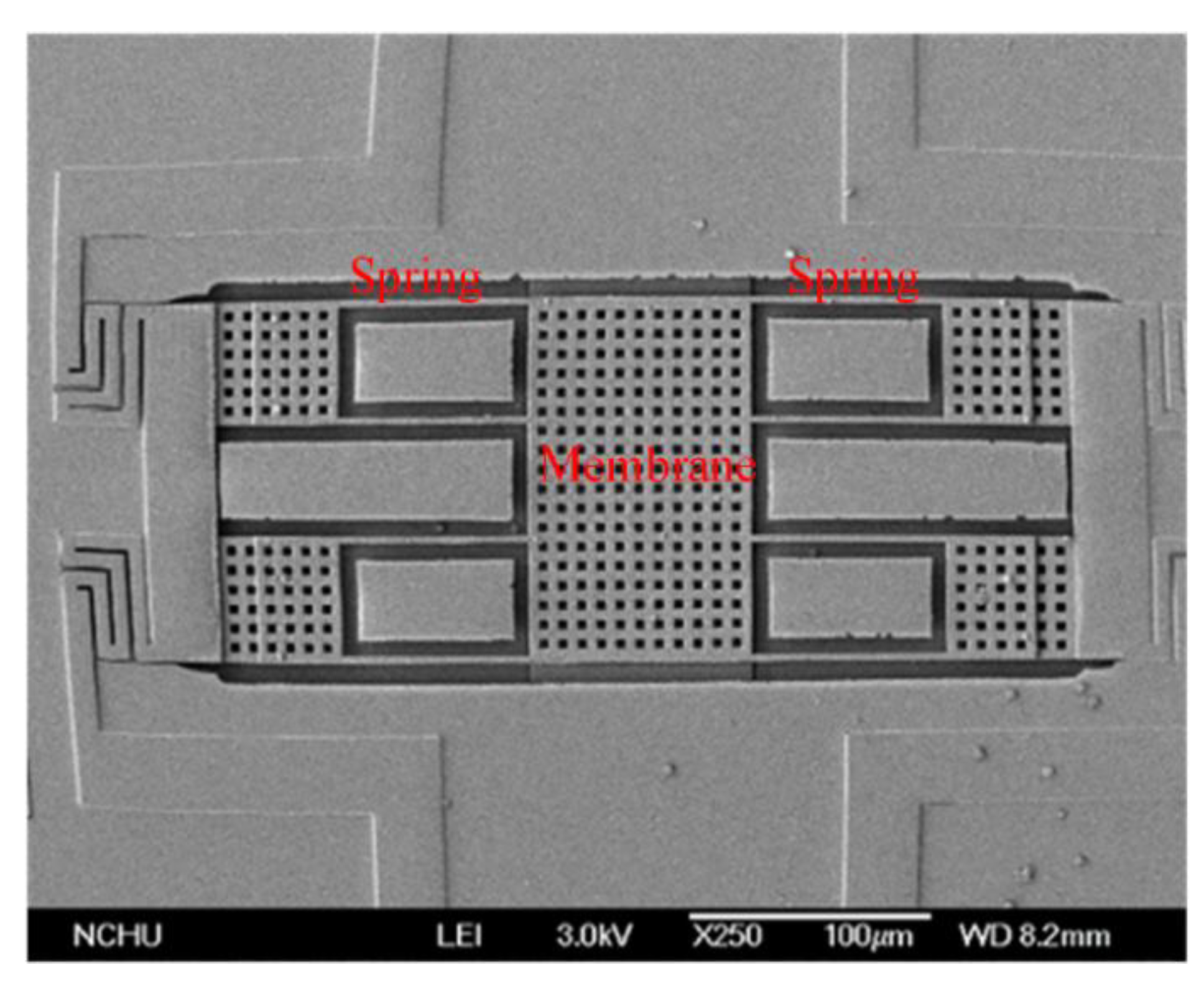
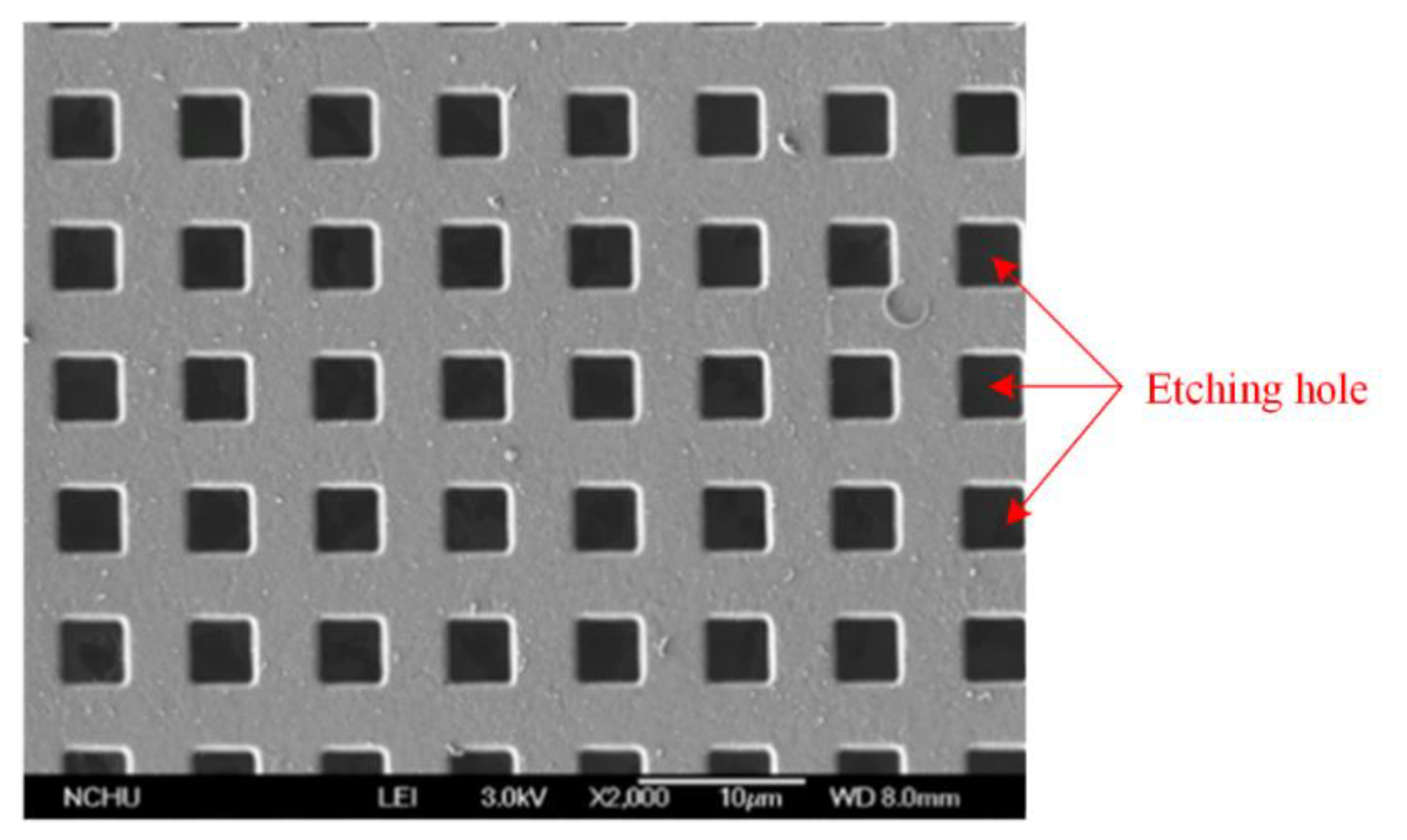
| Authors | Insertion Loss | Isolation | Actuation Voltage (V) |
|---|---|---|---|
| Chae et al. [8] | 0.23 dB at 6 GHz | 38.8 dB at 2.4 GHz | 15.4 |
| Swarnkar et al. [9] | 0.5 dB at 30 GHz | 30 dB at 30 GHz | 20 |
| Mafinejad et al. [10] | 1 dB at 21 GHz | 20 dB at 21 GHz | 18 |
| Anuroop et al. [11] | 0.3 dB at 10.9 GHz | 19.57 dB at 10.9 GHz | – |
| Savin et al. [12] | 2 dB at 20 GHz | 30.5 dB at20 GHz | 42 |
| Rao et al. [14] | 0.54 dB at 27 GHz | 72.4 dB at 27 GHz | 5.5 |
| Liu et al. [15] | 0.43 dB at 40 GHz | 36 dB at 40 GHz | 60 |
| Lin et al. [16] | 0.8 dB at 36 GHz | 19 dB at 36 GHz | 11 |
| Yang et al. [17] | 0.85 dB at 35 GHz | 25 dB at 35 GHz | 11 |
| This work | 0.9 dB at 41 GHz | 30 dB at 41 GHz | 10.5 |
Publisher’s Note: MDPI stays neutral with regard to jurisdictional claims in published maps and institutional affiliations. |
© 2021 by the authors. Licensee MDPI, Basel, Switzerland. This article is an open access article distributed under the terms and conditions of the Creative Commons Attribution (CC BY) license (http://creativecommons.org/licenses/by/4.0/).
Share and Cite
Tsai, Z.-Y.; Shih, P.-J.; Tsai, Y.-C.; Dai, C.-L. Manufacturing and Testing of Radio Frequency MEMS Switches Using the Complementary Metal Oxide Semiconductor Process. Sensors 2021, 21, 1396. https://doi.org/10.3390/s21041396
Tsai Z-Y, Shih P-J, Tsai Y-C, Dai C-L. Manufacturing and Testing of Radio Frequency MEMS Switches Using the Complementary Metal Oxide Semiconductor Process. Sensors. 2021; 21(4):1396. https://doi.org/10.3390/s21041396
Chicago/Turabian StyleTsai, Zung-You, Po-Jen Shih, Yao-Chuan Tsai, and Ching-Liang Dai. 2021. "Manufacturing and Testing of Radio Frequency MEMS Switches Using the Complementary Metal Oxide Semiconductor Process" Sensors 21, no. 4: 1396. https://doi.org/10.3390/s21041396
APA StyleTsai, Z.-Y., Shih, P.-J., Tsai, Y.-C., & Dai, C.-L. (2021). Manufacturing and Testing of Radio Frequency MEMS Switches Using the Complementary Metal Oxide Semiconductor Process. Sensors, 21(4), 1396. https://doi.org/10.3390/s21041396





